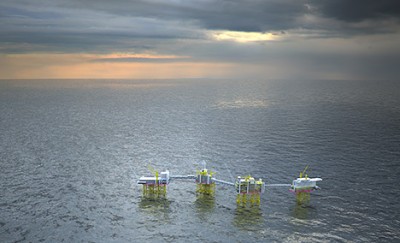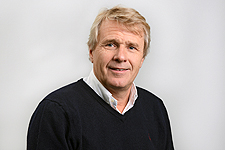Norwegian oil company Statoil released literally electrifying development plans on Thursday for the country’s promising new oil fields in the area of the North Sea called Utsira, off the west coast of Rogaland. Statoil called its decision to power Utsira’s Johan Sverdrup field with electricity from the mainland both “historic” and environmentally friendly, but it still didn’t satisfy environmentalists and opposition politicians in Parliament.

Statoil has been under huge pressure to power the new fields off Rogaland with electricity sent by cables from the mainland, instead of using gas from oil production. Electrification, it’s argued, can dramatically reduce carbon emissions and thus provide significant environmental advantages to help battle climate change.
The costs of electrification are high, though, and both Statoil and Norwegian government officials have seemed reluctant to commit to a project that could jeopardize the economic viability of the entire project. It involves several fields at Utsira including Johan Sverdrup and others now called Ivar Aasen, Gina Krog and Edvard Grieg after historic figures in Norway. In addition to Statoil, both Lundin of Sweden and Det norske oljeselskapet are field operators in the area.
‘Historic’ new concept
On Thursday, though, Statoil officials announced plans to go ahead with a development concept that at least will electrify the first phase of the Johan Sverdrup field, one of the largest ever found on the Norwegian continental shelf. Investment in the project’s first phase was estimated at up to NOK 120 billion (USD 19.6 billion), with the field expected to yield about 315,000 barrels of oil equivalents per day.
“This is historic.” said Arne Sigve Nylund, Statoil’s executive vice president for development and production in Norway. “We have not made a concept selection for a field this size since the 1980s.” Statoil said the field will be developed in several stages with production underway by the end of 2019. The field is expected to have a lifetime of 50 years.
Statoil estimates that with Sverdrup’s power supply coming from electricity generated ashore, stage-one emissions will be cut by up to 70 percent. Plans call for the first phase of Sverdrup to be powered by a transformer at Kårstø delivering direct current to the riser platform. An alternative power plan involves electricity from shore to the entire Utsira area.
The decision to electrify was made by Statoil and its partners in the field even though the government didn’t require it and despite its higher costs, but environmentalists still weren’t satisfied.
Critics not impressed
Heikki Holmås of the Socialist Left Party (SV), for example, claimed Statoil’s proposal does not go far enough to meeting Norway’s 2020 target of cutting emissions by 20 percent. He also claimed there is strong support within parliament, if not the government, to demand more environmentally friendly electrification solutions if new oil fields are to be developed.
“It will be extremely difficult to reach the target of climate compromise with this solution,” Holmås told NRK on Thursday. “Statoil chose to defy the Parliament with this solution.”
Other environmental leaders don’t want new oil and gas fields to be developed at all, and are urging government officials to stress alternative energy sources to make Norway less reliant on oil and gas.
Holmås claimed that the new Conservatives-led government “isn’t being tough enough” on Statoil, even though the same was often said about the former left-center government of which Holmås’ own party was a member.

Statoil senior vice president Øivind Reinertsen said the company has not yet decided on how the next stages of development will be powered, but stressed that Statoil is investigating powering the whole Ustira area from shore. “This alternative, if selected, has the potential to capture more than 90 percent of the total CO2 emissions from this area,” he said.
In the meantime, he claimed that the new oil field development in already mature areas off Norway’s west coast where much infrastructure already is in place will provide more jobs, help ensure the fortunes of Norway’s offshore industry and provide new energy sources in a relatively efficient manner. At its peak, analysts estimate Johan Sverdrup will make up a quarter of the Norwegian shelf’s oil production, churning out between 550,000-650,000 barrels of oil equivalent per day.
“The ambition is a recovery rate of 70 percent for the full field,” Reinertsen said. The field was discovered in two drilling operations between 2010 and 2011 at what were originally called the Avaldsnes and Aldous fields. They were renamed Johan Sverdrup when found to be one continuous field.
Phase One
The first NOK 100-120 billion investment will go into building a field centre with processing, drilling and riser platforms and living quarters. The platforms’ steel jackets will be linked by bridges. The budget also covers drilling wells, exporting the oil and gas, improving oil recovery methods and supplying power. The area’s water depth is 120 metres, and the reservoir is 1,900 metres deep. Statoil said the investment amount allows breathing room for market adjustments.
Harvested oil and gas will be transported through pipelines to shore. Oil will go to the Mongstad terminal in Hordaland, while gas will go to Kårstø in Rogaland for further processing.
Statoil said its full development and operation plans will go before Parliament for approvals by spring in 2015. Statoil’s partners in the entire project include Lundin, Maersk Oil, Petoro and Det norske oljeselskap.
Thursday’s announcement came in the wake of Statoil’s disappointing financial results at the start of February, and an acknowledgement that the company would have to reduce its capital expenditure.
newsinenglish.no/Emily Woodgate and Nina Berglund

